Attached files
| file | filename |
|---|---|
| 8-K - FORM 8-K - Duke Energy CORP | d8k.htm |
| EX-99.1 - JOINT PRESS RELEASE - Duke Energy CORP | dex991.htm |
 CREATING
THE LEADING U.S. UTILITY January 10, 2011
Exhibit 99.2
OH
KY
NC
SC
FL |
 Creating
the Leading U.S. Utility – January 10, 2011
Safe Harbor
2 |
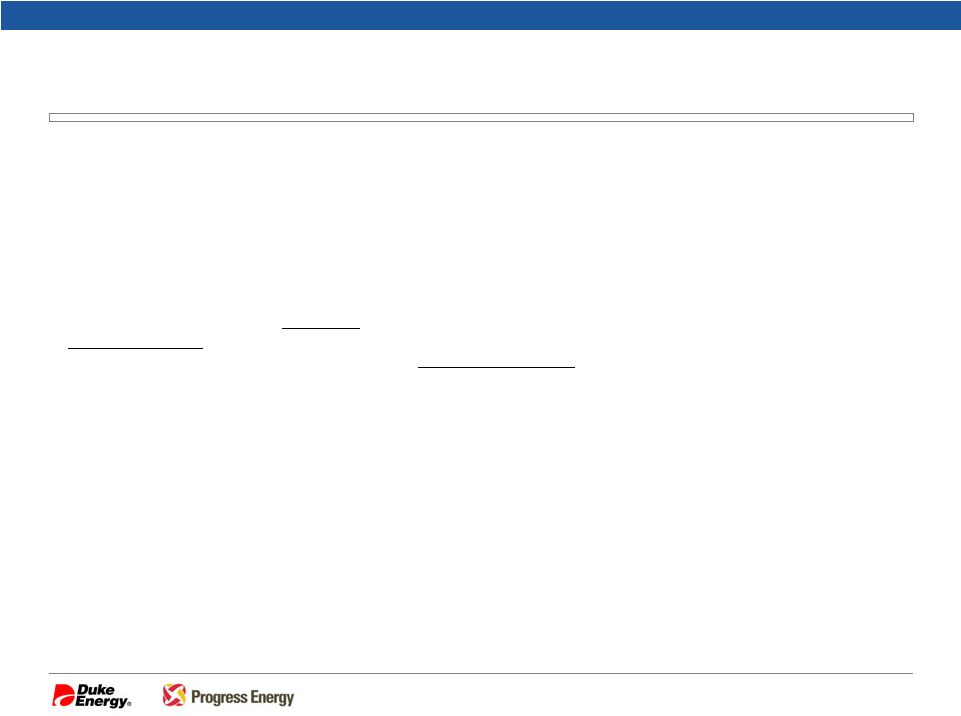 Creating
the Leading U.S. Utility – January 10, 2011
Safe Harbor (cont’d)
ADDITIONAL INFORMATION AND WHERE TO FIND IT
This document does not constitute an offer to sell or the solicitation of an offer to
buy any securities, or a solicitation of any vote or approval, nor shall there
be any sale of securities in any jurisdiction in which such offer, solicitation or sale would be unlawful prior to registration or
qualification
under
the
securities
laws
of
any
such
jurisdiction.
In
connection
with
the
proposed
merger
between
Duke
Energy
and
Progress
Energy, Duke Energy will file with the SEC a Registration Statement on Form S-4
that will include a joint proxy statement of Duke Energy and Progress Energy
that also constitutes a prospectus of Duke Energy. Duke Energy and Progress Energy will deliver the joint proxy
statement/prospectus to their respective shareholders. Duke Energy and Progress
Energy urge investors and shareholders to read the joint proxy
statement/prospectus regarding the proposed merger when it becomes available, as well as other documents filed with the
SEC, because they will contain important information.
You may obtain copies of all documents filed with the SEC regarding this transaction,
free of charge, at the SEC's
website (www.sec.gov). You may also obtain these documents, free of charge, from Duke
Energy’s website (www.duke-energy.com) under the heading
“Investors” and then under the heading “Financials/SEC
Filings.” You may also obtain these
documents,
free
of
charge,
from
Progress
Energy’s
website
(www.progress-energy.com)
under
the
tab
“Investors”
and
then
under
the
heading
“SEC Filings.”
PARTICIPANTS IN THE MERGER SOLICITATION
Duke Energy, Progress Energy, and their respective directors, executive officers and
certain other members of management and employees may be soliciting proxies from
Duke Energy and Progress Energy shareholders in favor of the merger and related matters. Information regarding
the persons who may, under the rules of the SEC, be deemed participants in the
solicitation of Duke Energy and Progress Energy shareholders in connection with
the proposed merger will be set forth in the joint proxy statement/prospectus when it is filed with the SEC. You can find
information about Duke Energy’s executive officers and directors in its definitive
proxy statement filed with the SEC on March 22, 2010. You can find information
about Progress Energy’s executive officers and directors in its definitive proxy statement filed with the SEC on March 31, 2010.
Additional information about Duke Energy’s executive officers and directors and
Progress Energy’s executive officers and directors can be found in
the
above-referenced
Registration
Statement
on
Form
S-4
when
it
becomes
available.
You
can
obtain
free
copies
of
these
documents
from
Duke Energy and Progress Energy using the contact information above.
3 |
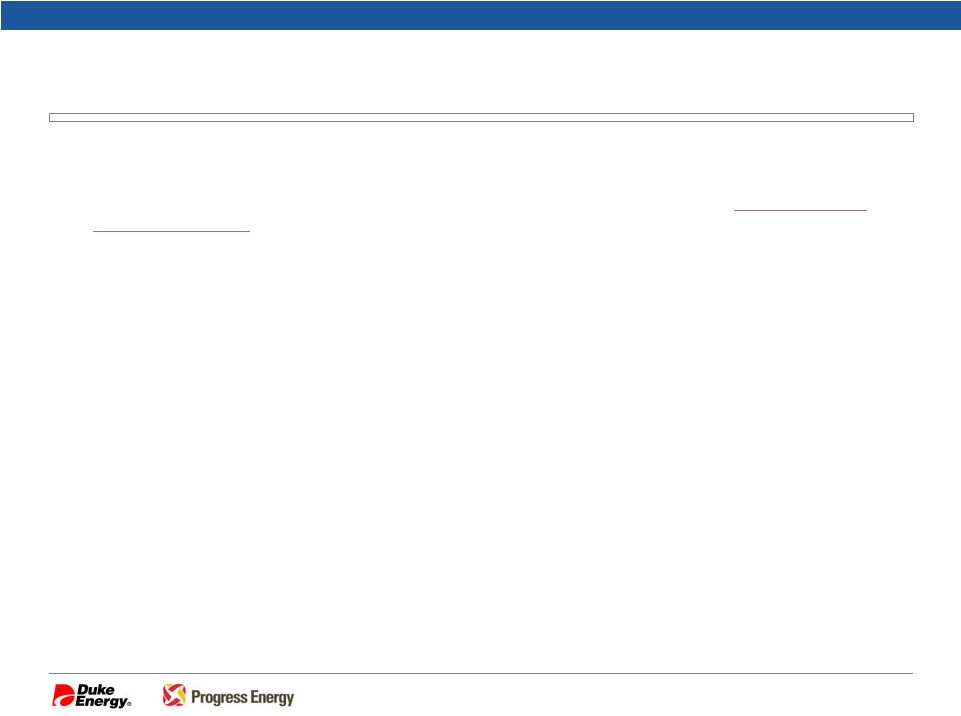 Creating
the Leading U.S. Utility – January 10, 2011
Safe Harbor (cont’d)
REG G DISCLOSURE
In addition, today's discussion includes certain non-GAAP financial measures as
defined under SEC Regulation G. A reconciliation of those measures
to
the
most
directly
comparable
GAAP
measures
is
available
on
our
Investor
Relations
websites
at
www.duke-energy.com
and
www.progress-energy.com. 4
|
 Creating
the Leading U.S. Utility – January 10, 2011
Agenda
Transaction Overview
Company Highlights
Financial Summary
Closing |
 Creating
the Leading U.S. Utility – January 10, 2011
Transaction Overview |
 Creating
the Leading U.S. Utility – January 10, 2011
7
Compelling Strategic Transaction
Creates largest U.S. utility, supported by substantial, diversified regulated earnings
and cash flows
Unmatched financial and operational scale, scope and strength
Principally regulated earnings base supports dividend
Significant scale of operating cash flows
Highly-regulated business mix
Regulated: comprises approximately 85% of combined company adjusted
segment EBIT
Non-regulated: comprises approximately 15% of combined company adjusted
segment EBIT
Overall
Strategic
Benefits
1
Duke Energy’s forecasted 2010 adjusted EBIT based upon midpoint of
original 2010 adjusted diluted EPS range of $1.25 - $1.30; excludes operations labeled
as ‘Other’; Progress Energy’s forecasted 2010 adjusted EBIT based upon
midpoint of original 2010 ongoing EPS range of $2.85 - $3.05 1
1
Leverages “best-in-class” operational and customer service practices
Enhances industry leadership position to shape federal and state energy policies
|
 Creating
the Leading U.S. Utility – January 10, 2011
8
Compelling Strategic Transaction (cont’d)
Earnings
accretive
in
year
one
Attractive total shareholder return proposition supported by strong dividend
Maintain Duke Energy dividend and policy
Significant
rate
base
growth
expected
to
drive
4-6%
long-term
EPS
growth
Strong balance sheet and credit profile
Investor
Benefits
Ability to derive meaningful operational efficiencies for regulated electric customers
over time
Significant benefits to Carolinas customers from fuel and joint dispatch
efficiencies Continued commitment to delivering clean, affordable and reliable
energy to our customers
Strong, complementary management teams
Experience with execution of large-scale merger transactions
Management
Expertise
Customer
Benefits
1
Based upon adjusted diluted earnings per share. Long-term EPS growth rate off
a stand-alone Duke Energy base year of 2011 1
1 |
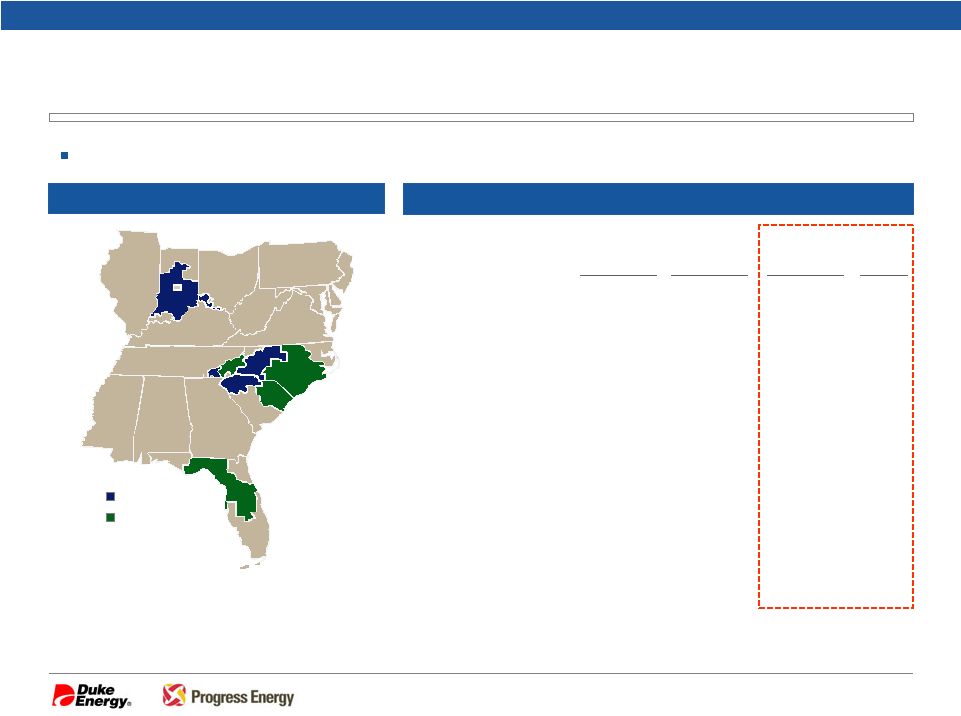 Creating
the Leading U.S. Utility – January 10, 2011
Diverse Service Territories
Creating the Largest U.S. Utility
The combined company will create the largest U.S. utility, with unmatched scale and
scope Combined Statistics
Enterprise Value
$40.2 B
$25.1 B
$65.3 B
#1
Market Cap.
$23.6 B
$12.8 B
$36.5 B
#1
Electric Customers
4.0 M
3.1 M
7.1 M
#1
Generation Capacity
35.4 GW
21.8 GW
57.2 GW¹
#1
Total Assets
$57.9 B
$32.7 B
$90.6 B
#1
Rate Base
$23 B
$17 B
$40 B
#1
Regulated EBIT Mix
77%
100%
85%
N/A
Duke
Energy
Progress
Energy
Combined
Rank
IN
Duke Energy
Progress Energy
IN
9
OH
KY
NC
SC
FL
2
3
1
Source: FactSet as 12/31/2010
Note: Customer data as of 12/31/2009; rate base data estimated as of 12/31/2010; total
assets and generation capacity as of 09/30/2010 ¹ Excludes purchased power
and approximately 4 GW of Duke Energy International assets ² Total assets
are a summation of the two stand-alone companies and do not include any purchase accounting adjustments from this transaction.
3
Duke Energy’s forecasted 2010 adjusted EBIT based upon midpoint of original 2010
adjusted diluted EPS range of $1.25 - $1.30; excludes operations labeled as ‘Other’; Progress Energy’s forecasted 2010 adjusted EBIT
based upon midpoint of original 2010 ongoing EPS range of $2.85 - $3.05
|
 Creating the Leading U.S. Utility –
January 10, 2011
10
Key Transaction Terms
Following shareholder vote and regulatory approvals, targeting closing transaction
by end of 2011
Timing/Approvals
Corporate: Charlotte; significant presence in Raleigh
Utilities: No change
Headquarters
100% stock
2.6125 shares of Duke Energy per Progress Energy share
Consideration
Duke Energy shareholders: 63%
Progress Energy shareholders: 37%
Pro Forma Ownership
Executive Chairman: Jim Rogers
President and CEO: Bill Johnson
Board
composition
11 nominated
by Duke Energy, including
Jim Rogers
7 nominated
by Progress Energy, including
Bill Johnson
Lead
Director
to be
designated
by Duke Energy
Governance
Duke Energy Corporation
Company Name |
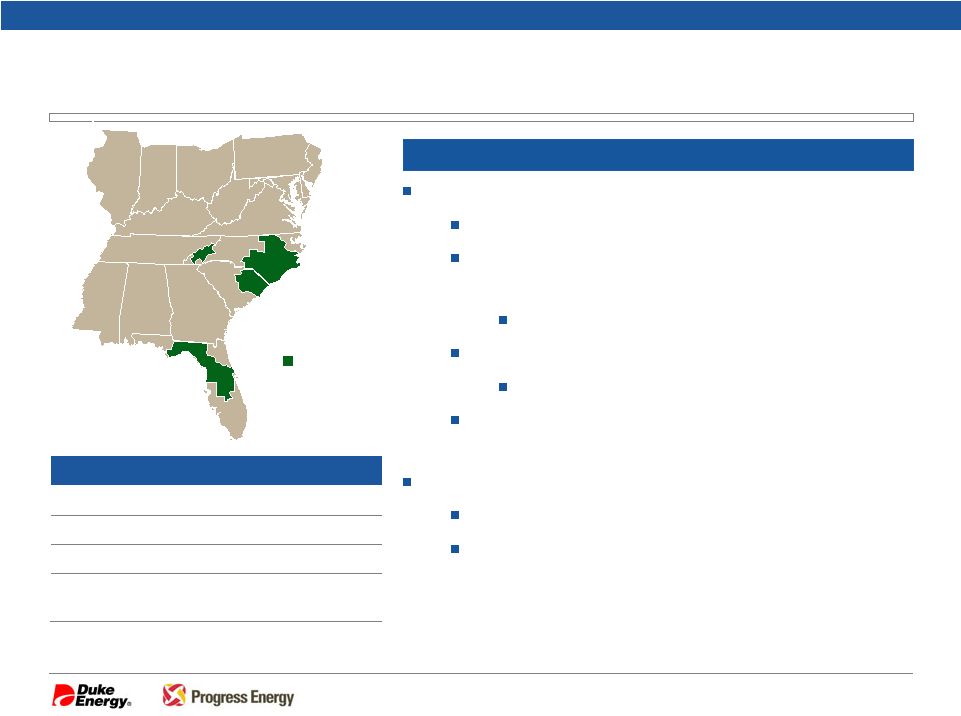 Creating the Leading U.S. Utility –
January 10, 2011
11
Duke Energy Transaction Rationale
Investor and strategic benefits
EPS accretive in year one¹
Creates unmatched financial and operational scale,
scope and strength
Poised for strong growth and economic recovery
Expanded U.S. regulated earnings base and cash flows
Operating in constructive regulatory environments
Improved business risk profile due to increased
proportion of regulated earnings and cash flows
Significant customer benefits
Fuel and joint dispatch savings in the Carolinas
Operational efficiencies through leveraging mutual “best-
in-class”
customer
service
capabilities
Transaction Rationale
¹
Based on adjusted diluted EPS
2
Generation capacity as of 09/30/2010; excludes purchased power
Progress Energy at a Glance
Generation
21.8 GW
Rate base
~$17 B (estimated as of 12/31/10)
Customers
3.1 M (electric)
Jurisdictions
North Carolina, South Carolina and
Florida
Progress Energy
NC
SC
OH
KY
IN
FL
2 |
 Creating the Leading U.S. Utility –
January 10, 2011
12
Progress Energy Transaction Rationale
Transaction Rationale
¹
Premium expressed relative to unaffected Progress Energy 1/05/2011 closing share price
of $43.39. The premium to the Progress Energy 1/07/2011 closing share price of $44.72 is 3.9%.
²
Based on adjusted diluted EPS
3
Generation capacity as of 09/30/2010; excludes purchased power and approximately 4 GW
of Duke Energy International assets Investor and strategic benefits
7.1%
premium
to
Progress
Energy
shareholders
1
Dividend
and
EPS
accretive
in
year
one
2
Improved EPS & dividend growth
Increased regulatory and earnings diversity in six
service territories
Improved business risk profile due to stronger balance
sheet and credit metrics
Enhanced growth opportunities and strategic optionality
Significant customer benefits
Fuel and joint dispatch savings in the Carolinas
Operational efficiencies through leveraging mutual
“best-in-class”
customer service capabilities
Duke Energy at a Glance
Generation
35.4 GW
Rate base
~$23 B (estimated as of 12/31/10)
Customers
4.0 M (electric); 0.5 M (gas)
Jurisdictions
North Carolina, South Carolina,
Indiana, Ohio and Kentucky
Duke Energy
IN
NC
FL
OH
KY
SC
3 |
 Creating the Leading U.S. Utility –
January 10, 2011
Highly Experienced Leadership Team
18 Member Board of Directors
Bill Johnson
President & CEO
Lynn Good
Chief Financial Officer
Mark Mulhern
Chief Administrative Officer
Keith Trent
Commercial Businesses
Jennifer Weber
Chief Human Resources Officer
Dhiaa
Jamil
Nuclear Generation
John McArthur
Regulated Utilities
Marc Manly
General Counsel
Jeff Lyash
Energy Supply
Lloyd Yates
Customer Operations
Chief Integration Officers
A.R. Mullinax
Paula Sims
Jim Rogers
Executive Chairman
13 |
 Creating the Leading U.S. Utility –
January 10, 2011
Indicative Timeline to Close and Regulatory Approvals
Q1 2011
Q2 2011
Q3 2011
Q4 2011
Merger announcement
Make regulatory filings
North Carolina,
South Carolina,
U.S. DOJ,
FERC, and NRC
File joint proxy
statement
Secure appropriate state and
federal regulatory approvals
Duke Energy and Progress
Energy shareholder meetings
Develop and initiate transition implementation plans
Close merger
(Targeted)
We will work collaboratively with all of our state regulators
14 |
 Creating the Leading U.S. Utility –
January 10, 2011
Company Highlights |
 Creating the Leading U.S. Utility –
January 10, 2011
16.0
21.8
23.7
24.9
25.6
27.9
28.3
37.0
42.7
42.9
35.4
57.2
PF DUK
SO
NEE
AEP
DUK
CPN
ETR
D
EXC
FE/AYE
PGN
PEG
Enterprise Value ($ B)
$23.6
$24.9
$25.1
$32.5
$33.6
$35.0
$37.8
$40.2
$41.5
$41.6
$65.3
$52.7
PF DUK
SO
D
NEE
DUK
EXC
AEP
FE/AYE
PCG
PGN
PEG
ETR
Market Capitalization ($ B)
$12.8
$12.9
$15.4
$16.1
$17.3
$19.3
$21.8
$23.6
$24.8
$27.5
$36.5
$32.4
PF DUK
SO
EXC
D
DUK
NEE
PCG
AEP
PEG
FE/AYE
ETR
PGN
The Leading U.S. Utility
#1 U.S. utility by enterprise value
$65.3 B enterprise value
24% larger than the #2 utility
$90.6
B
in
total
assets
#1 U.S. utility by market capitalization
$36.5 B equity value
13% larger than the #2 utility
#1 U.S. utility by generation capacity
57.2 GW total capacity
33% larger than the #2 generator
Capacity Owned (GW)
16
1
Source: Market data as of 12/31/2010, company filings; capacity owned as of 09/30/2010
for Duke Energy and Progress Energy; as of 12/31/2009 for other companies Total assets are as of 9/30/2010 and are a summation of the two stand-alone
companies and do not include any purchase accounting adjustments from this transaction.
1 |
 Creating the Leading U.S. Utility –
January 10, 2011
By Type: 235 TWh
By Geography
Attractive, Diversified Operations
Presence in six attractive growth service territories with constructive regulatory
traditions More electric
customers
than
any
other
U.S.
utility,
serving
7.1
M
domestic
regulated
electric
customers
Customer Diversity: 7.1 M regulated customers
FL
23%
Carolinas
54%
Residential
35%
Commercial
30%
Wholesale/Other
15%
Industrial
20%
IN
16%
Carolinas
54%
OH
6%
FL
22%
KY
2%
IN
11%
OH
10%
KY
2%
Rate Base Diversity: $40 B
Note: Customer data as of 12/31/2009; rate base data estimated as of 12/31/2010
(see Note on slide 24); customer data only includes regulated customers
Duke Energy
Progress Energy
NC
SC
FL
OH
Diverse Service Territories
17
IN
KY |
 Creating the Leading U.S. Utility –
January 10, 2011
Highly diversified generation capacity and fuel profile
Capacity and
fuel
diversity
projected
to
increase,
migrating
the
combined
fleet
to
greater
gas
and
less
coal
exposure
By Actual Generation: 231 TWh¹
Source: SNL Energy, Ventyx, company filings
¹
Note: Capacity owned as of 09/30/2010 excludes approximately 4 GW of Duke Energy
International assets. Actual generation includes twelve-months ended 12/31/2009 and excludes purchased power
U.S. Generation Diversity
Nuclear
15%
Gas/Oil
27%
Coal
42%
By Owned Capacity: 57 GW¹
Gas/Oil
48%
Coal
48%
Hydro/Wind
11%
Nuclear
16%
Gas/Oil
35%
Coal
33%
Hydro/Wind
7%
Coal
42%
Gas/Oil
25%
Nuclear
32%
Duke Energy
Progress Energy
Combined
Hydro/Wind
1%
Duke Energy
Progress Energy
Combined
Hydro/Wind
1%
Coal
62%
Nuclear
31%
Coal
54%
Nuclear
31%
Gas/Oil
13%
Hydro/Wind
2%
Nuclear
17%
Gas/Oil
5%
Hydro/Wind
2%
18 |
 Creating the Leading U.S. Utility –
January 10, 2011
19
U.S. Generation Well Positioned for Pending
Environmental Regulations
Announced Retirements
Duke Energy
1.9
Progress Energy
1.5
Subtotal
3.4
Potential Additional Retirements/Investments
Duke Energy
2.2
Progress Energy
1.0
Subtotal
3.2
Total Unscrubbed Coal
6.6
Unscrubbed
Coal Capacity (GW)
Generation Capacity by Technology (GW / %)
Duke Energy
Progress Energy
Combined
Unscrubbed
Coal
4.0 GW / 11%
Gas/Oil
9.4 GW / 27%
Non-Emitting¹
9.1 GW / 26%
Scrubbed Coal
12.9 GW / 36%
Unscrubbed
Coal
6.6 GW / 11%
Gas/Oil
19.9 GW / 35%
Non-Emitting¹
13.1 GW / 23%
Scrubbed Coal
17.6 GW / 31%
Unscrubbed
Coal
2.5 GW / 12%
Gas/Oil
10.5 GW / 48%
Non-Emitting¹
4.0 GW / 18%
Scrubbed Coal
4.7 GW / 22%
¹ Duke Energy: Nuclear (15%), Hydro (9%), Renewables (2%); Progress Energy:
Nuclear (17%), Hydro (1%); Combined: Nuclear (16%), Hydro (6%), Renewables (1%)
Note: Generation capacity as of 09/30/2010 excludes approximately 4 GW of Duke
Energy International assets |
 Creating the Leading U.S. Utility –
January 10, 2011
Source: SNL Energy, Ventyx, company filings
Note: Capacity owned as of 09/30/2010 for Duke Energy and Progress Energy; as of
12/31/2009 for other companies Nuclear Generation Overview
Nuclear Generation Capacity Owned (GW)
17.0
10.1
2.2
2.2
3.7
3.7
3.8
4.0
5.2
5.5
5.8
9.0
EXC
ETR
PF
DUK
D
NEE
DUK
FE/AYE
PGN
SO
PEG
PCG
AEP
Combination creates the largest U.S. regulated nuclear fleet
7 stations and 12 units with ~9 GW of owned generation
Commitment to top quartile operational performance for nuclear
fleet
Combination of nuclear fleets to drive best practices and
achieve operating efficiencies
Size and scale better positions combined company for the
continued pursuit of new nuclear development opportunities
COLs
have been filed with the NRC for three potential
sites
New nuclear will only be pursued with the appropriate
regulatory recovery mechanisms in place
Duke Energy
Progress Energy
NC
SC
FL
Oconee
McGuire
Catawba
Crystal
River
Robinson
Brunswick
Harris
Combined Nuclear Generation Fleet
20
Creating the Leading U.S. Utility –
January 10, 2011 |
 Creating the Leading U.S. Utility –
January 10, 2011
Financial Summary |
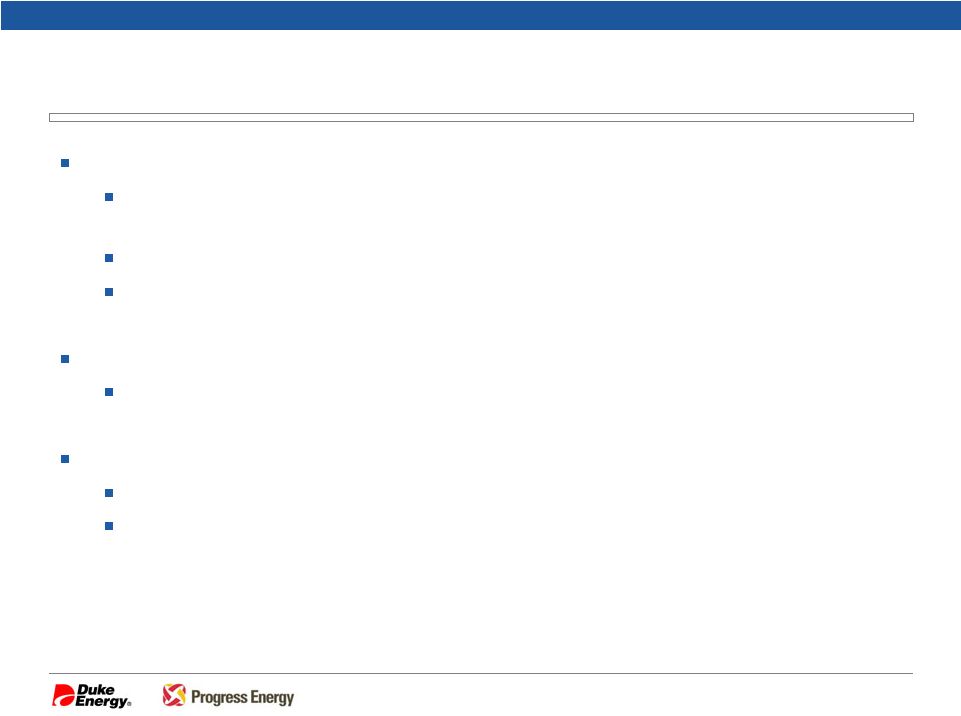 Creating the Leading U.S. Utility –
January 10, 2011
Accretive
to
earnings
in
the
first
year
after
close
Joint dispatch
and
fuel
savings
will
immediately
benefit
Carolinas’
customers
($600
-
800
M
from
2012 -
2016)
Non-fuel merger benefits help achieve first year earnings accretion
No equity issuance requirements assumed
Long-term adjusted diluted EPS CAGR target: 4 –
6%
Principally driven by significant regulated capital investment opportunities
Duke Energy reverse stock split at transaction close
Split ratio to be determined prior to closing
Exchange ratio in the merger will be appropriately adjusted to reflect the reverse
split Pro Forma Earnings Profile
Based upon adjusted diluted earnings (excludes costs to achieve)
Based upon base year of 2011
22
1
1
2
2 |
 Creating the Leading U.S. Utility –
January 10, 2011
Predominantly Regulated Earnings Base
and Cash Flows
Business Mix
Commercial
Power
9%
Regulated
~100%
Duke Energy
2010E EBIT: ~$3.4 B
Progress Energy
Combined
Regulated
77%
2010E EBIT: ~$2.1 B
DEI
9%
2010E EBIT: ~$5.5 B
Regulated
85%
DEI
14%
Commercial
Power
6%
Regulated EBIT contribution of the combined operations will be approximately 85%
Duke Energy is committed to growing its strong regulated earnings base
23
Note: Duke Energy’s forecasted 2010 adjusted EBIT based upon midpoint of original
2010 adjusted diluted EPS range of $1.25 - $1.30; excludes operations labeled as ‘Other’
Progress Energy’s forecasted 2010 adjusted EBIT based upon midpoint of original
2010 ongoing EPS range of $2.85 - $3.05 |
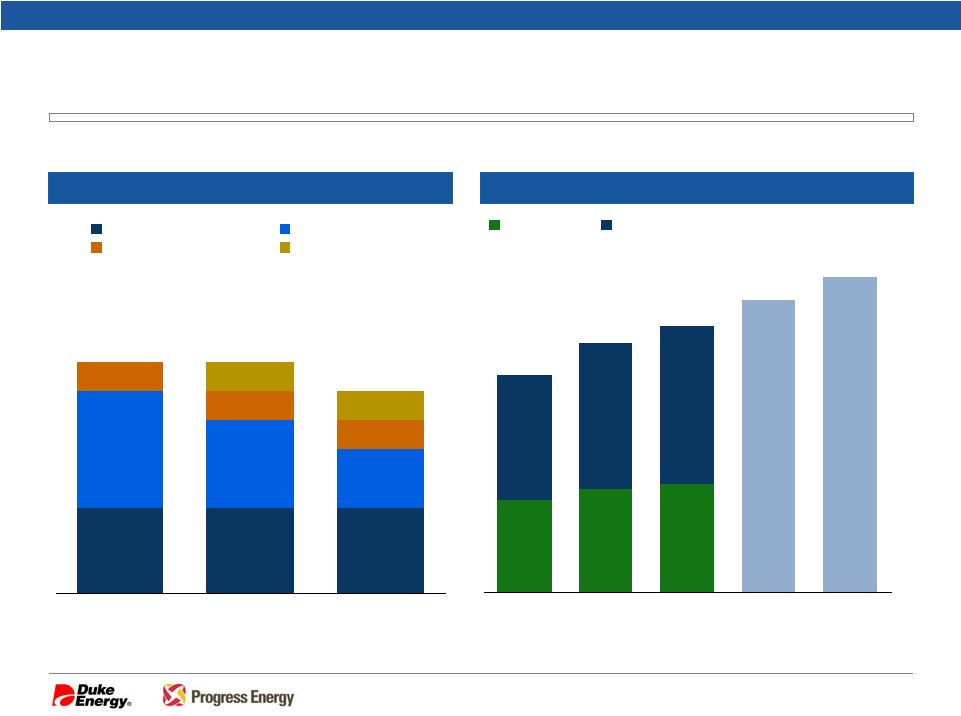 Creating the Leading U.S. Utility –
January 10, 2011
Projected Rate Base ($ B)
Attractive Rate Base Growth
$17
$19
$20
$23
$27
$29
$49
$46
$40
2010E
2011E
2012E
2013E
2014E
Progress Energy
Duke Energy
$3
$3
$3
$4
$3
$2
$1
$1
$1
$1
$1
$8
$8
$7
2010E
2011E
2012E
Regulated Maintenance
Regulated Growth
Non-Regulated
Discretionary Range
Projected Capital Expenditures ($ B)
Illustrative
24
Note: Forecasted capital expenditures are based on the original 2010-2012E
standalone forecasts of Duke Energy and Progress Energy, as disclosed in February 2010, respectively, as well as the midpoint of Duke
Energy’s expected discretionary capital expenditure range; Projected rate base
includes both retail and wholesale; Duke Energy’s projected rate base is based upon estimated amounts which would be expected to
qualify for rate base treatment at each period and is not based upon actual expected
timing of rate base changes resulting from rate cases. |
 Creating the Leading U.S. Utility –
January 10, 2011
Attractive Dividend Policy
Duke Energy dividend and policy to be maintained
Continued growth in dividend at a rate slower than growth of adjusted diluted
EPS Targeting a long-term payout range of 65% to 70%
Attractive payout and yield underscores compelling shareholder value proposition
Dividend quality supported by strong pro forma regulated earnings base
Duke Energy and Progress Energy have 84 and 65-year histories, respectively, of
consecutive quarterly cash dividend payments
DUK Annual Dividend Per Share History
Source: FactSet
Based upon adjusted diluted EPS
2007 decrease due to the spin-off of Spectra Energy to shareholders on 1/2/2007 as
dividends subsequent to the spin-off were split proportionately between Duke Energy and Spectra Energy such that the sum of the
dividends of the two stand-alone companies approximated the former total dividend
prior to the spin-off Note: Annual dividends are split-adjusted and
reflect annualized Q4 dividend per share for each year $0.98
$0.96
$0.92
$0.88
$1.28
$1.24
$1.10
$1.10
$1.10
$1.10
$1.10
$1.10
$1.10
$1.10
$1.06
$1.02
$0.98
$0.94
$0.90
$0.86
$0.82
$0.78
$0.74
$0.70
$0.67
$0.65
$0.62
$0.59
$0.57
$0.55
$0.51
1985
1987
1988
1989
1990
1991
1992
1993
1994
1995
1996
1997
1998
1999
2000
2001
2002
2003
2004
2005
2006
2007
2008
2009
2010
Spectra
Energy
Spin-Off²
1980
1981
1982
1983
1984
1986
25
1
1
2 |
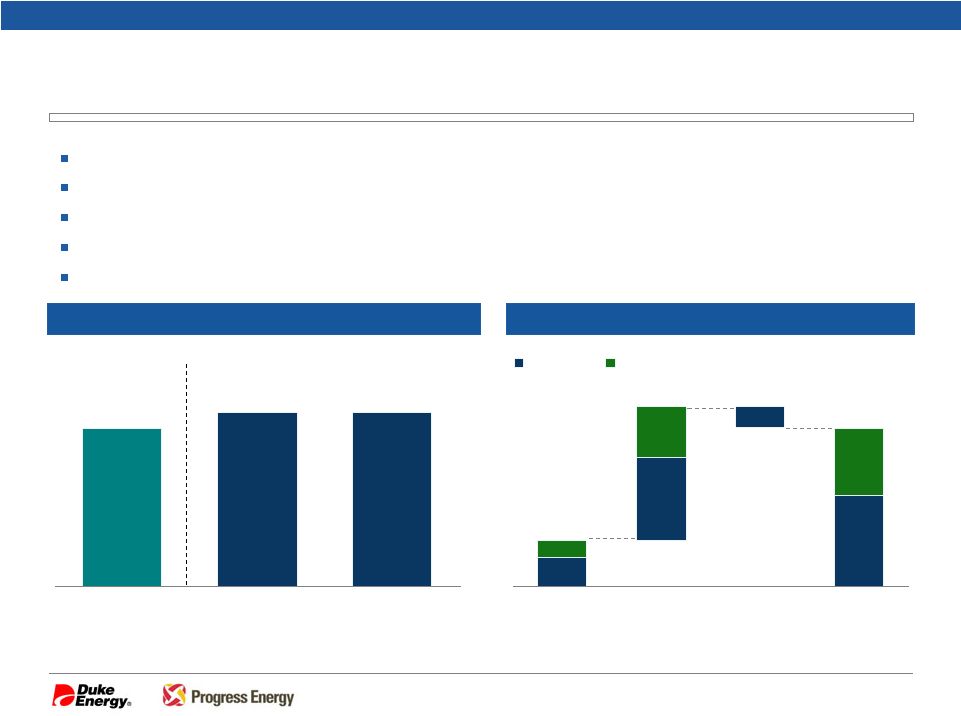 Creating the Leading U.S. Utility –
January 10, 2011
Strong Credit Quality and Liquidity
$0.7
$2.0
$2.7
$1.1
$3.3
$3.6
$0.8
$1.8
$5.3
$6.3
$0.8
Duke Energy
Progress Energy
Pro Forma Liquidity ($ B)
Projected Debt/Total Capitalization
50%
51%
51%
Note: Debt/Total Capitalization is unadjusted; 2011E is estimated as transaction is not
targeted to close until end of 2011
1
2012E
2013E
2011E
Cash and
equivalents
Total Available
Credit Facilities
Utilized
Amount
Available
Liquidity
Highly committed to Duke Energy’s current strong credit ratings
Lower overall risk profile resulting from increased regulated earnings base and cash
flows Strong
balance
sheet
strength
with
$91
B
in
total
assets
Increased regulatory diversity with presence in six traditionally constructive
regulatory jurisdictions Broad and reliable access to capital markets and
liquidity 26
Total assets are as of 9/30/2010 and are a summation of the two
stand-alone companies and do not include any purchase accounting adjustments
from this transaction. Note: Pro forma liquidity is as of 09/30/2010; Duke Energy cash and equivalents
excludes certain cash and short-term investments in foreign
jurisdictions of approximately $675 M 1 |
 Creating the Leading U.S. Utility –
January 10, 2011
Shareholder Value Track Record
15.1%
(8.3%)
12.0%
5.7%
(15.4%)
20.9%
9.5%
4.7%
44.2%
12.6%
7.9%
32.3%
Total Shareholder Return (%)
S&P 500
UTY
Duke
Energy
Progress
Energy
1 year
S&P 500
UTY
3 year
S&P 500
UTY
5 year
Source: Bloomberg as of 12/31/2010
Duke
Energy
Progress
Energy
Duke
Energy
Progress
Energy
27 |
 Creating the Leading U.S. Utility –
January 10, 2011
Closing |
 Creating the Leading U.S. Utility –
January 10, 2011
29
Summary Highlights
Creates largest U.S. utility, supported by substantial, diversified regulated earnings
and cash flows Unmatched financial and operational scale, scope and
strength Principally regulated earnings base supports dividend
Significant scale of operating cash flows
Leverages
“best-in-class”
operational
and
customer
service
practices
Enhances
industry
leadership
position
to
shape
federal
and
state
energy
policies
Highly-regulated business mix
Regulated:
comprises
approximately
85%
of
combined
company
adjusted
segment
EBIT
Non-regulated:
comprises
approximately
15%
of
combined
company
adjusted
segment
EBIT
1
1
Duke Energy’s forecasted 2010 adjusted EBIT based upon midpoint of original 2010
adjusted diluted EPS range of $1.25 - $1.30; excludes operations labeled as ‘Other’; Progress Energy’s forecasted
2010 adjusted EBIT based upon midpoint of original 2010 ongoing EPS range of $2.85
- $3.05 1 |
 Creating the Leading U.S. Utility –
January 10, 2011
Appendix |
              Creating
the Leading U.S. Utility – January 10, 2011
31
Simplified Financing Structure by Legal Entity
Commercial Paper and LT Financings
Project / International Financings
Money Pool and LT Financings
Duke Energy
(HoldCo)
Duke Energy
(HoldCo)
Duke Energy
Carolinas
Duke Energy
Carolinas
Duke Energy
International
Duke Energy
International
Duke Energy
Ohio
Duke Energy
Ohio
Duke Energy
Kentucky
Duke Energy
Kentucky
Duke Energy
Indiana
Duke Energy
Indiana
Other Non-Reg
Other Non-Reg
Progress Energy
Carolinas
Progress Energy
Carolinas
Progress Energy
Florida
Progress Energy
Florida
Issuer Legend
Dormant Entity
Existing Debt But No Future Issuance
Cinergy Corp.
(HoldCo)
Progress Energy
(HoldCo) |
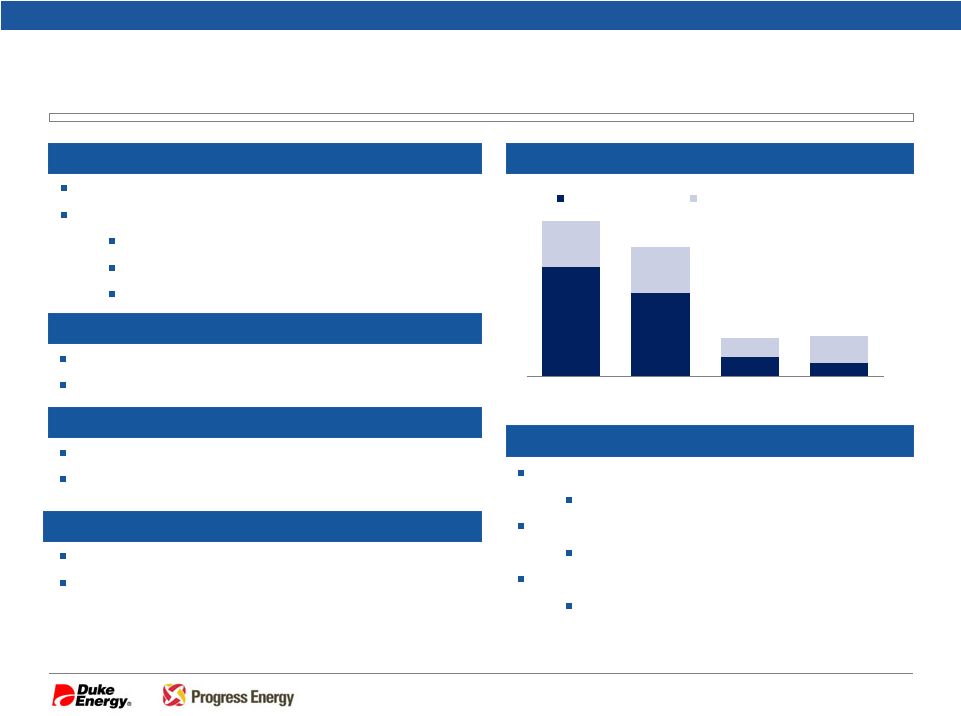 Creating the Leading U.S. Utility –
January 10, 2011
Duke Energy –
Summary of Major Capital Projects
32
1
Project costs include direct capital and AFUDC
Edwardsport
–
Indiana
618 MW IGCC facility expected in-service in 2012
Project status (as of 09/30/10)
Overall project: 74% complete
Final engineering: over 90% complete
Construction: 52% complete
Cliffside –
Carolinas
825 MW advanced clean-coal unit expected in-service in 2012
Project is 72% complete and on budget (as of 09/30/10)
Buck –
Carolinas
620 MW combined-cycle gas-fired plant expected in-service in 2011
Project is 15% complete (as of 09/30/10)
Dan River –
Carolinas
620 MW combined-cycle gas-fired plant expected in-service in 2012
Project broke ground Q4-2010
US FE&G Major Construction Projects¹
($ M)
Renewables
Projects
Top of the World –
200 MW
In-service ahead of schedule and under budget
Kit Carson –
51 MW
In-service ahead of schedule and under budget
Blue Wing –
14 MW
In-service ahead of schedule and on budget
$2,025
$1,550
$350
$225
$855
$850
$350
$485
Edwardsport
Cliffside
Buck CC
Dan River CC
Spent as of 09/30/10
Estimated expenditures to complete project |
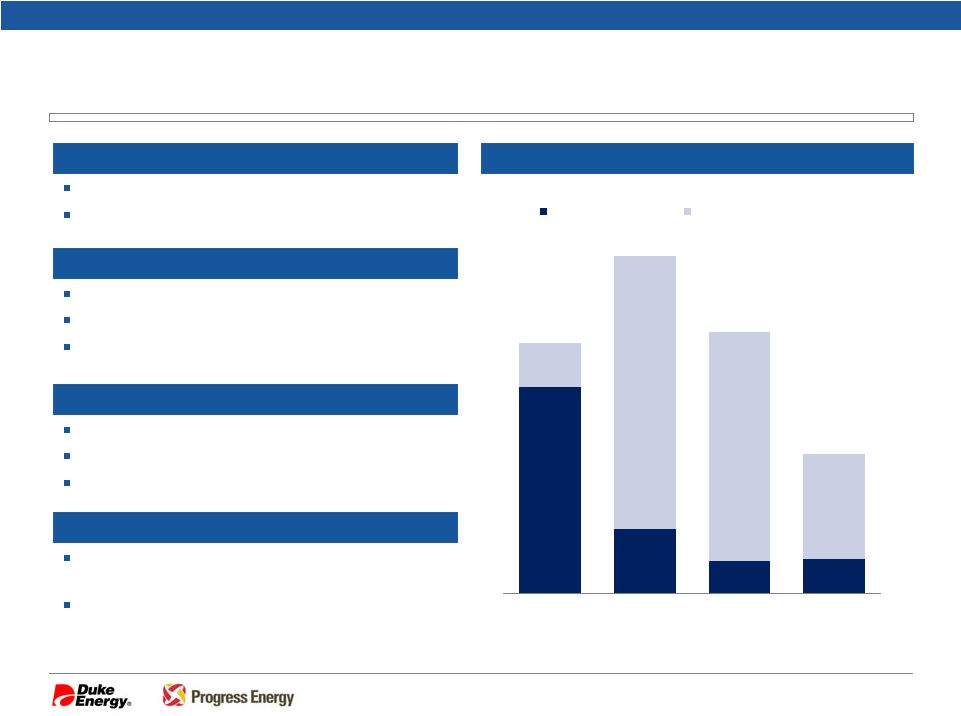 Creating the Leading U.S. Utility –
January 10, 2011
Progress Energy –
Summary of Major Capital Projects
33
$475
$150
$75
$80
$100
$625
$525
$240
Richmond
County
Lee
Sutton
Smart Grid
Spent as of 09/30/10
Estimated expenditures to complete project
Richmond County CCGT –
North Carolina
635 MW combined-cycle gas-fired plant
Expected in-service in June 2011
Lee CCGT –
North Carolina
920 MW combined-cycle gas-fired plant
Project broke ground in September 2010
Expected in-service in January 2013
Sutton CCGT –
North Carolina
625 MW combined-cycle gas-fired plant
Construction is expected to begin in 2H-2011
Expected in-service in January 2014
Smart Grid –
Carolinas & Florida
Received $200M grant from the DOE in August 2009
($100M each for PEC and PEF)
Leverages already-planned investments of $320M
($200M for PEC and $120M for PEF)
Progress
Energy
Major
Construction
Projects¹
($
M)
Project costs include direct capital, AFUDC and the cost of all transmission additions
and upgrades necessary to integrate the generator into the system.
1 |
 Creating the Leading U.S. Utility –
January 10, 2011
Example calculation of Progress Energy dividend based on Duke Energy’s
current annual dividend per share
Duke Energy annual dividend
Multiplied by: exchange ratio
Progress Energy exchange-ratio adjusted dividend
Progress Energy current annual dividend
Progress Energy expected dividend accretion
Dividend Accretion to Progress Energy –
Illustrative Example
Current
$0.98
2.6125x
$2.56
$2.48
$0.08 or 3.2%
Pro Forma
1-for-2
Stock Split
$1.96
1.30625x
$2.56
$2.48
$0.08 or 3.2%
Dividend accretion to Progress Energy is expected to increase over time given Duke
Energy’s historical dividend per share growth rate of ~2%
1
Stock split ratio to be determined subsequently; 1-for-2 used for illustrative
purposes only 34
1 |
 Creating the Leading U.S. Utility –
January 10, 2011 |
